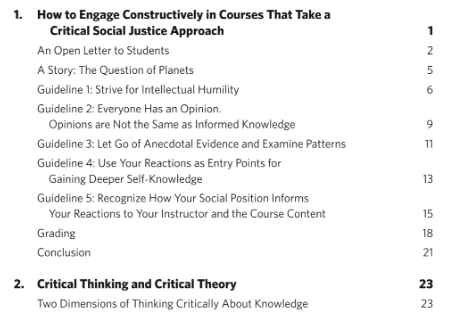University of Wisconsin – Stevens Point (CorruptED)
Incidents
The University of Wisconsin at Stevens Point College of Education’s courses feature content such as critical theory, critical race theory, intersectionality, and oppression. Course texts include Ozlem Sensoy and Robin DiAngelo’s Is Everyone Really Equal? An Introduction to Key Concepts in Social Justice Education and Ibram X. Kendi’s How to Be an Antiracist.
COURSES
EDSU 921: Building Equitable Education Systems: Understanding Race, Ethnicity, Power, and Privilege
The course titled EDSU 921 – Building Equitable Education Systems: Understanding Race, Ethnicity, Power, and Privilege features topics such as critical race theory, intersectionality, oppression, power, and privilege.
Course “learning outcomes” include students being able to “interpret race, ethnicity, power and privilege in the education system,” “analyze multiple forms of oppression and their intersections,” “apply social theory and critical race theory within teaching and learning environments,” and “propose actions to enhance equity in the education system.”


English Education Methods
The document titled English Ed Methods, which includes “English 355/555: Methods of Teaching Composition,” “English 356/556: Methods of Teaching Literature,” “English 396: Practicum,” and “English 497: English Education Seminar,” states that the “primary goal over the course of this semester, however, is to help you [student] develop into careful, critical, antiracist English Language Arts educators.”
The courses emphasize that students “practice critical literacy” and “antiracist pedagogy.” The words “critical literacy” is found 23 times in the document.


According to Google AI, critical literacy is “a teaching method that uses critical theories to analyze, critique, and transform social norms, practices, and rule systems.”

As part of the English 355/356 course, students must complete a project titled “Course/Unit/Lesson Plan Assessment” where they will “plan a course, design a unit, create daily lesson plans, and construct assignments for a particular group of students.”
When creating the project, students are also to “consider the different genders, gender identities, races, ethnicities, nations, cultures, psychological development, socio-emotional development, and socioeconomic status of all of your students, and incorporates critical literacy and personally and culturally sustaining pedagogies.”

As part of the project, students are to assess the “intersectionalities of people in the community” and create their own “‘Intersectionality Wheel’ for the community based on the patterns of data from your research.” The directions also state that the students should “include race and racism” in their choices.
Students must choose “at least four items per level” which features the level “systems and structures of power” and includes items such as “politics,” “capitalism,” and “colonization,” as well as the “major systems of oppression” level which includes “racism,” “ableism,” “classism,” and “heterosexism.”


The course “English Education 396: English Education Practicum” states that its purpose is to help guide students in “developing professional processes that help you consider the skills, ideas, and educational frameworks” and features Ibram X. Kendi’s How to Be an Antiracist as the core course text.

EDUC 205: Pluralism
The course EDUC 205 Pluralism states that it is “founded on the assumption that there is injustice in the world and that inequities exist.” The course “analyzes and evaluates education in the U.S., the policy of equal educational opportunity, and the impact of class, gender, race, and language differences in teaching and learning.”
The course includes readings from Is Everyone Really Equal? An Introduction to Key Concepts in Social Justice Education by Ozlem Sensoy and Robin DiAngelo which contains topics focusing on critical theory, oppression and power, privilege, racism, and white supremacy.

Stay Informed
